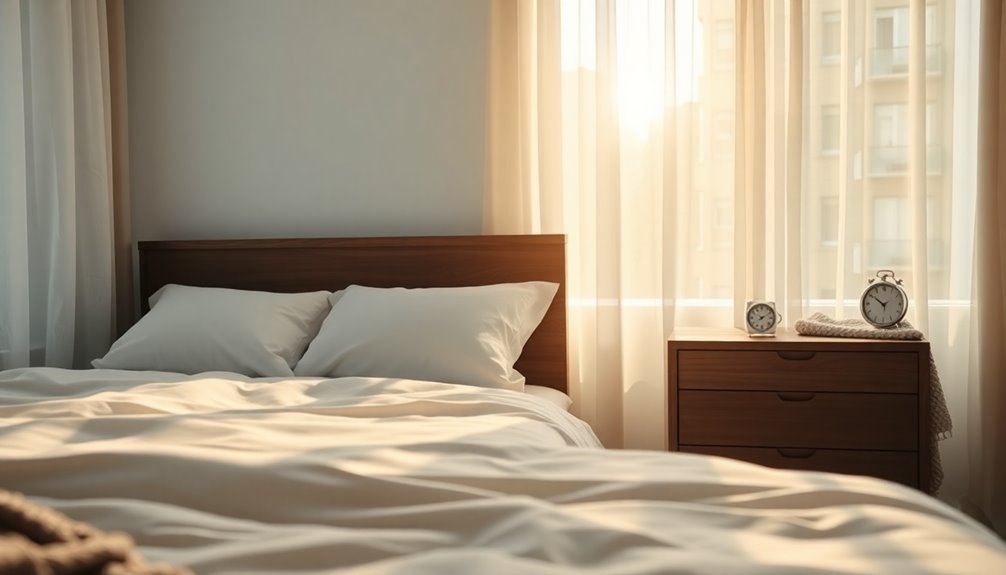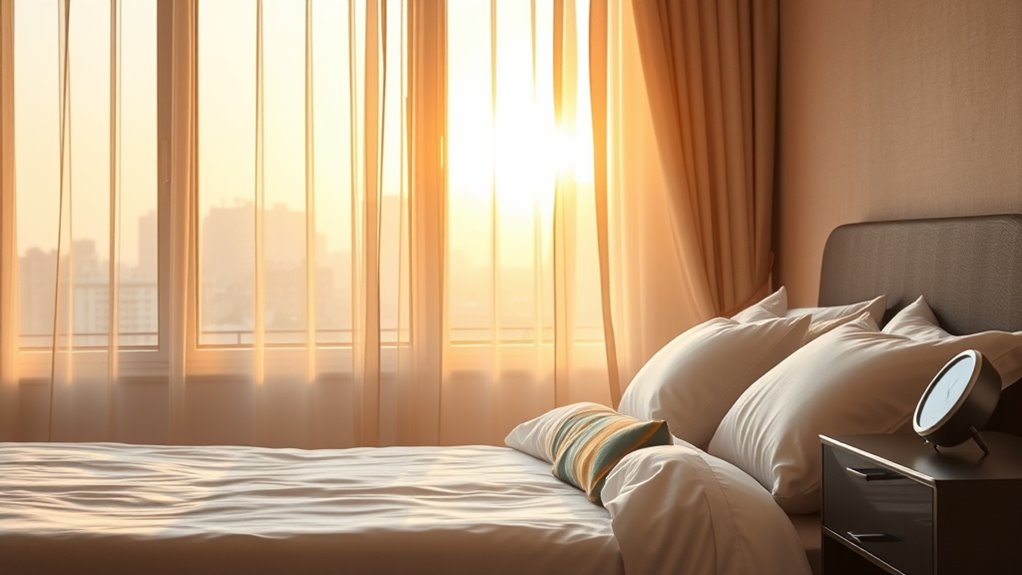Understanding your sleep chronotype helps you tailor your schedule to your biological clock. Whether you’re a morning lark or a night owl, recognizing your natural sleep and wake preferences allows you to optimize alertness and performance. By tracking your habits and adjusting gradually, you can align your routines with when your body naturally feels most energetic. Keep exploring, and you’ll discover practical tips to make your sleep pattern work best for you.
Key Takeaways
- Identify your natural sleep and alertness times by tracking sleep patterns without external pressures.
- Recognize if you’re a morning (lark) or evening (owl) chronotype through behavioral cues and sleep habits.
- Adjust your sleep schedule gradually (15-30 minutes) to align with your biological clock.
- Use natural light strategically—morning sunlight for early types, blue light blocking for night owls.
- Maintain consistent wake times to reinforce your circadian rhythm and optimize your sleep schedule.
Understanding Different Sleep Chronotypes

Understanding different sleep chronotypes involves recognizing that people have natural preferences for when they sleep and wake, driven by their biological clock. Your circadian rhythm influences not only your sleep schedule but also alertness, appetite, exercise capacity, and core body temperature throughout the day. Variations in these rhythms create distinct chronotypes, such as morning types (larks) who wake early and are most alert in the morning, or evening types (owls) who prefer later sleep and wake times. Some people fall into intermediate or neutral categories, adapting more easily to social schedules. Differences in sleep pressure buildup contribute to these behaviors, with evening types accumulating sleepiness more slowly and morning types feeling sleepy earlier. Genetics and environment shape your natural sleep preferences, affecting your daily functioning. Additionally, sleep pressure plays a key role in determining your alertness levels and sleepiness at different times of the day. Understanding how circadian rhythm interacts with sleep pressure can help you optimize your sleep schedule for better health and productivity. Recognizing your unique sleep chronotype can also improve your overall well-being by aligning your activities with your natural energy peaks.
How Your Biological Clock Affects Daily Performance

Your biological clock plays a crucial role in determining when you perform at your best throughout the day. Circadian rhythms, governed by your genes and synchronized by the SCN, regulate alertness, mood, and physical strength. Most people experience peak energy and performance in the early evening when core body temperature is highest. Hormones like cortisol and testosterone follow daily cycles, influencing energy levels and muscle performance. These rhythms also prepare your body for environmental changes, such as day and night. Disruptions to your circadian clock—caused by irregular sleep or light exposure—can impair focus, stamina, and recovery. Understanding how your biological clock influences daily performance helps you plan activities for when you’re naturally most alert and capable. Additionally, cheating behaviors and related emotional responses can sometimes disrupt sleep patterns, further affecting your circadian rhythms and overall performance. Recognizing the importance of sleep quality can aid in maintaining a healthy rhythm and optimizing daily function. Maintaining a consistent sleep schedule and exposure to natural light can help reinforce your biological rhythms and improve overall well-being. Moreover, aligning your daily routine with your sleep chronotype can enhance productivity and health outcomes.
Recognizing Your Personal Sleep and Wake Preferences

To effectively align your daily routines with your natural rhythms, it’s important to recognize your personal sleep and wake preferences. Start by observing when you naturally feel sleepy and alert without alarms or external pressures. Pay attention to the times you fall asleep easily and wake feeling refreshed. Keep track of your energy levels throughout the day—when you feel most alert or sluggish. Use self-report questionnaires or note your sleep timing on free days to identify patterns. Notice behavioral cues, like when you prefer to exercise or eat, which also reflect your chronotype. Monitoring how easily you wake up and your sleep latency can offer further clues. Additionally, understanding your sleep chronotype helps you better understand your biological clock and set routines that support your well-being. Recognizing the associated headphone preferences can also enhance your relaxation and sleep quality by creating an optimal auditory environment. Being aware of sleep patterns can help you adjust your schedule to improve overall sleep health and daily functioning. Recognizing your personality traits may influence your sleep preferences and routines, leading to more personalized strategies. Incorporating awareness of your gelato cravings during different times of the day can also reflect your body’s natural energy fluctuations and preferences.
Adjusting Your Routine to Match Your Chronotype

Adjusting your routine to match your chronotype involves making small, deliberate changes to your sleep and wake times. Shift your schedule gradually in 15-30 minute increments to avoid disrupting your circadian rhythm and reduce sleep onset delays. Consistency is key—keep your wake times steady to reinforce your internal clock. Use light exposure strategically: bask in natural sunlight in the morning if you’re an early type, or employ blue light blocking in the evening if you’re a night owl. Incorporating relaxing activities before bed can ease the transition into your new schedule. Avoid screens and bright lights at least an hour before sleep, and create a dark, comfortable environment. Additionally, understanding the importance of natural techniques for successful seed production can inspire similar sustainable practices in managing your routine and environment. Recognizing your cultural preferences can also help tailor your schedule to fit your personal and cultural needs, making it easier to maintain consistency. Being aware of different sleep cycle patterns may help you optimize your rest and productivity. These adjustments help your body align more naturally with your preferred sleep-wake cycle, promoting better rest and alertness.
Tips for Maintaining a Consistent and Restorative Sleep Schedule

Maintaining a consistent and restorative sleep schedule requires establishing regular sleep and wake times that align closely with your natural circadian rhythm. Go to bed and wake up at the same times daily, including weekends, to reinforce your body’s internal clock. Keep a fixed wake-up time as an anchor, and gradually shift your bedtime by 15-30 minutes if needed. Aim for at least seven hours of sleep nightly, syncing your schedule with natural daylight and darkness. Create a calming pre-sleep routine—like reading or listening to music—and dim lights to boost melatonin production. Keep your bedroom quiet, dark, and cool. Limiting naps, caffeine, and heavy meals late in the day can help improve sleep quality. Consistency is key to deep, restorative sleep and overall health. Incorporating healthy kid play activities during the day can also promote better sleep patterns. Additionally, using an air purifier can help maintain clean indoor air, reducing allergens and pollutants that may disrupt sleep. Ensuring your environment is free of disruptive noise or light can further enhance sleep quality and duration. Practicing good sleep hygiene habits is essential for achieving restful sleep and supporting overall well-being. Being mindful of potential cybersecurity vulnerabilities in your smart home devices can help prevent disruptions to your sleep environment.
Frequently Asked Questions
Can My Chronotype Change Over Time?
Yes, your chronotype can change over time. While genetics influence your natural sleep-wake cycle, your habits and environment also play a role. You can shift toward an earlier or later chronotype by adjusting your light exposure, sleep routine, and lifestyle. Consistent effort can lead to lasting changes, improving your sleep quality and daily alertness. Keep in mind, these changes are possible but may require patience and commitment.
How Does Age Influence Sleep Chronotypes?
Did you know that 55% to 64% of sleep chronotype differences occur between ages 15 and 25? As you age, your sleep preferences tend to shift earlier, starting in your late 20s. By your 60s, many people prefer going to bed and waking up earlier due to physiological changes. These shifts are influenced by aging, hormonal changes, and lifestyle, leading to earlier sleep-wake times in older adults.
Are There Health Risks Linked to Mismatched Routines?
You should know that mismatched routines pose serious health risks. When your sleep schedule is irregular, you increase your chances of heart attack, stroke, obesity, and diabetes. Disrupted sleep patterns also lower your sleep quality, cause daytime fatigue, and impair your mood and cognitive function. Even if you get enough sleep overall, inconsistent timings still elevate your risk for long-term health issues like cardiovascular disease and metabolic disorders.
Can Adjusting My Schedule Improve Sleep Quality?
Adjusting your schedule can definitely improve your sleep quality. By gradually shifting your bedtime and wake-up time, you help reset your internal clock, making it easier to fall asleep and stay asleep. Consistency is key, so sticking to a routine even on weekends matters. Using strategies like light therapy or a relaxing bedtime routine can further support your adjustment, leading to better rest and overall health.
How Do Shift Work and Jet Lag Affect My Chronotype?
Imagine you’re a night-shift worker. Shift work and jet lag disrupt your natural sleep pattern, causing circadian misalignment. For example, early chronotypes struggle more, accumulating social jetlag and experiencing poorer health. Your body’s internal clock gets thrown off, making it harder to sleep and recover. To manage this, you can use strategies like light exposure or gradual schedule shifts, helping your chronotype adapt and reducing negative impacts.
Conclusion
Discovering your sleep chronotype helps you understand your body, align your routines, and optimize your performance. By recognizing your natural rhythms, adjusting your schedule, and maintaining consistency, you create a sustainable, restorative sleep pattern. Embrace your unique biological clock, respect your personal preferences, and commit to a routine that supports your well-being. When you listen to your body, honor your rhythms, and prioritize rest, you set the foundation for a healthier, more energized life.









